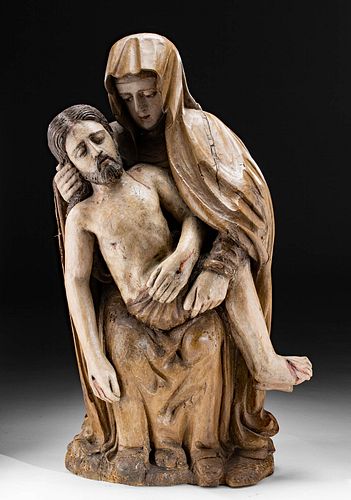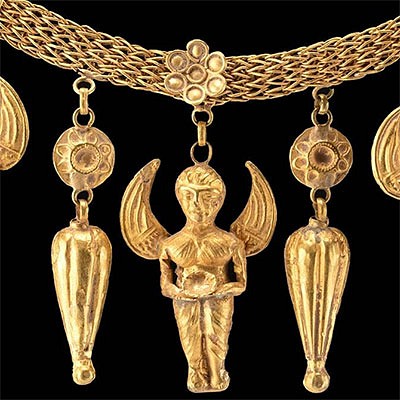16th C. German / Austrian Limewood Pieta Sculpture
Lot 137a
About Seller
Artemis Gallery
686 S Taylor Ave, Ste 106
Louisville, CO 80027
United States
Selling antiquities, ancient and ethnographic art online since 1993, Artemis Gallery specializes in Classical Antiquities (Egyptian, Greek, Roman, Near Eastern), Asian, Pre-Columbian, African / Tribal / Oceanographic art. Our extensive inventory includes pottery, stone, metal, wood, glass and textil...Read more
Categories
Estimate:
$2,000 - $3,000
Absentee vs Live bid
Two ways to bid:
- Leave a max absentee bid and the platform will bid on your behalf up to your maximum bid during the live auction.
- Bid live during the auction and your bids will be submitted real-time to the auctioneer.
Bid Increments
| Price | Bid Increment |
|---|---|
| $0 | $25 |
| $300 | $50 |
| $1,000 | $100 |
| $2,000 | $250 |
| $5,000 | $500 |
| $10,000 | $1,000 |
| $20,000 | $2,500 |
| $50,000 | $5,000 |
| $100,000 | $10,000 |
| $200,000 | $20,000 |
About Auction
By Artemis Gallery
Dec 3, 2020
Set Reminder
2020-12-03 10:00:00
2020-12-03 10:00:00
America/New_York
Bidsquare
Bidsquare : Fine Antiquities, Ethnographic & Fine Art
https://www.bidsquare.com/auctions/artemis-gallery/fine-antiquities-ethnographic-fine-art-6119
Features classical antiquities, ancient and ethnographic art from cultures encompassing the globe. Egyptian, Greek, Roman, Etruscan, Near Eastern, Asian, Pre-Columbian, Native American, African / Tribal, Oceanic, Spanish Colonial, Russian, Fine Art, so much more! All legally acquired, legal to sell. Artemis Gallery info@artemisgallery.com
Features classical antiquities, ancient and ethnographic art from cultures encompassing the globe. Egyptian, Greek, Roman, Etruscan, Near Eastern, Asian, Pre-Columbian, Native American, African / Tribal, Oceanic, Spanish Colonial, Russian, Fine Art, so much more! All legally acquired, legal to sell. Artemis Gallery info@artemisgallery.com
- Lot Description
Europe, Germany or Austria, Northern Renaissance, ca. 1520. Wow! A truly remarkable carved limewood Pieta of sizable form painted in shades of tan, brown, cream, and red and highly burnished. Gracefully draped in a long veil and robe, the Virgin Mary sits, holding her lifeless son, Jesus, who has just descended from the cross, as her right hand gently supports his head and her left grasps his thighs, covered in a loin cloth. Framed by a wimple, the Blessed Mother's sweet visage solemnly gazes down toward Christ, her heavy lidded almond-shaped eyes sit below a furrowed brow, as though tears are about to run down her naturalistic nose and red bowed lips. Similarly, the Son of God is shown defeated; his shoulders slanted as his lifeless right arm falls down along Mary's leg and his left lays across his body. Drill holes in his hands and feet are painted red to represent the stigmata (the wounds Christ obtained from his crucifixion), while a small incision on his right rib cage shows where he was pierced by the lance of Longinus and additional red blood, from injuries from his flagellation, drip where his forehead meets his long brown hair, just below his forked beard from his shoulder, and across his torso. Note the youthfulness of Mary, symbolizing her incorruptible purity. Size: 11.5" L x 5.25" W x 23.875" H (29.2 cm x 13.3 cm x 60.6 cm)
Though this Pieta is very similar to Michelangelo's monumental marble version finished in 1499 in Rome, it is unlikely Michelangelo's Pieta was used as inspiration for this piece, considering the difficulty of a German / Austrian sculptor gaining access to the Vatican before 1520 and the lack of a known print of Michelangelo's Pieta in circulation during this time. It is more likely, however, that the artist used a 15th century German woodcut for reference, as many displayed a similar form, such as that of Albrecht Durer in Volume 10 of The Illustrated Bartsch.
One of the most interesting aspects of this piece is its date and location. Carved in 1520 in Northern Europe, this statue was created only 3 years after Martin Luther's posting of the 95 Theses in Wittenberg, Germany, which sparked the Protestant Reformation. As the one of the main tenants of Luther's new religion was sola scriptura (by scripture alone), the veneration of religious images became likened with idolatry, a practice specifically forbidden by God as part of the Ten Commandments, and outbursts of iconoclastic riots, in which Christians destroyed religious images by breaking, burning, and even defecating on them, became prevalent all over Northern Europe throughout the 1520s. Remarkably, however, this piece survived.
The Pieta is a common subject of Christian art, one of the Sorrows of the Virgin Mary that arose as a focus for devotion during the Middle Ages and that continues today as part of Marian worship. Mary holds her only son after he has been taken down from the cross, lamenting his death. This is one of the darkest moments of the New Testament and the somber tones and dark patina of this figure contribute to the outpouring of grief that it engenders.
Provenance: ex Estate of Eldert Bontekoe, Pegasi Numismatics, Ann Arbor, Michigan, USA, acquired before 2000
All items legal to buy/sell under U.S. Statute covering cultural patrimony Code 2600, CHAPTER 14, and are guaranteed to be as described or your money back.
A Certificate of Authenticity will accompany all winning bids.
We ship worldwide and handle all shipping in-house for your convenience.
#159158Jesus is missing right foot. Large stable crack along back, as well as many stable hairline fissures throughout. Expected surface wear with nicks/chips and abraded areas, commensurate with age. Otherwise, excellent with impressive remaining pigment and some encrustations in recessed areas.Condition
- Shipping Info
-
All shipping is handled in-house for your convenience. Your invoice from Artemis Gallery will include shipping calculation instructions. If in doubt, please inquire BEFORE bidding for estimated shipping costs for individual items.
-
- Buyer's Premium



 EUR
EUR CAD
CAD AUD
AUD GBP
GBP MXN
MXN HKD
HKD CNY
CNY MYR
MYR SEK
SEK SGD
SGD CHF
CHF THB
THB















